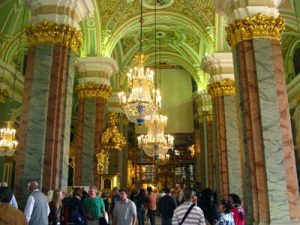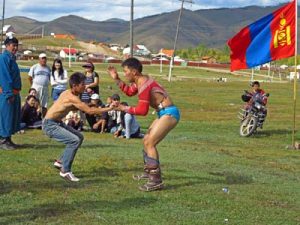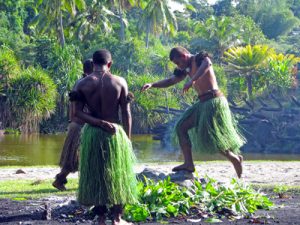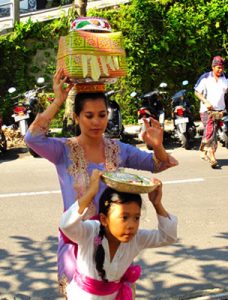by Irene Butler
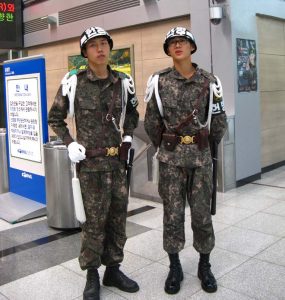
Day Trips from Seoul to the Demilitarized Zone or DMZ attract visitors from around the globe – over three million a year, according to our tour guide Lee.
Rick and I, along with another half-dozen tourists exit South Korea’s high tech, yet traditional capital city.
Our driver, Mrs. Wong handles our tour van like a jet-plane, while Lee imparts facts, “North and South Korea are divided at the 38th parallel, the original boundary decided by the USA and Russia at the end of WWII. During the Cold War this border was a hotbed of tension. The Korean War began in 1950 when the North invaded the South. In 1953, with international intervention, both sides pulled their troops back and borders were set with a 4km buffer zone in between – the DMZ”.
Shuttled from our van to a bus authorized to enter the DMZ area, we are taken to Dora Observatory. No photos are allowed from the viewing platform, but for 500 Korean Won (50 cents CND) crowds line up for a peek through a telescopic lens for any movement on the North Korean side. Instead we walk up the hill alongside the observatory where not-far-off barbed wire defines the South border and the no-man’s-land beyond.
Dorasan Station is next, a 40-million-dollar structure built in 2002 for inter-travel and freight between the countries in conjunction with the development of Kaesong Industrial Complex (10k inside the North) wherein South Korean owners utilize the North’s cheaper labour in the manufacture of items such as shoes and clothing. “For whatever reason,” says Lee, “in 2008 the North Korean government chose another route for this collaborative economic venture – leaving this station a useless shell.” Well, except for us tourists vying for photos with soldiers who although appearing much younger, must be at least 18 to comply with 21 months of military service by South Korea between ages 18 to 35. Women’s duty is optional. In North Korea 10 years of military service is mandatory for men, 7 for women.
It is onward to the 3rd Infiltration Tunnel – out of the 4 (that have been discovered so far) dug by the North to invade the South. The 3rd Tunnel was found in 1978 based on tips from a North Korean defector. Its location is a mere 52km from Seoul. It runs through bedrock below ground at a depth of 73m, its length is 1.6km, and is 2m wide and 2m in height – capable of moving thousands of weapon toting soldiers through per hour.
Chilled by more than cold damp air, I forge deeper and deeper into the tunnel with wet rubber mats underfoot and dripping rock walls; the hardhat I am wearing often clunks on an irregular piece of jagged ceiling rock. Before reaching the border there is a barricade of stone with a small opening from which to see that the tunnel indeed goes on into North Korea. “The North claim the South dug the tunnel,” says Lee, “but proof it was the other way around is the orientation of the blast lines and downward slope towards the North, so digging debris could be removed as the tunnel progressed.” This slope is readily apparent by the way I propel down with ease and labour to get back to the entrance.
Although our tour only passes by the village of Panmunjom located inside the DMZ, it should not go without mention. Known as the JSA (Joint Security Area), buildings lie on both sides of the Military Demarcation line (DML) separating North and South Korea. Some situated right on top of the dividing line is where the 1953 negotiations were held, and all meetings between the countries since.
The feeling of being at the DMZ is sobering and most unusual – what you don’t see has more prominence than what you do see – it is the lurking unpredictability of ongoing tensions between the Democratic South and the Communist North. This remains one of the most heavily guarded zones on the planet with a long list of sporadic hostile outbreaks with casualties in the hundreds between 1953 to present day. The tour is a mix of history, today’s reality, and hope for peace between nations.
More Info:
Many Tour Companies offer tours into the DMZ area and JSA. Lists of recommended tour companies can be obtained from hotels in South Korea.

South Korea 8-Night Comprehensive Tour from Seoul
About the author:
Irene Butler is an award winning travel writer and author of “Trekking the Globe with Mostly Gentle Footsteps” now on Kindle. Her articles have appeared in national and international publications. She and her photographer husband Rick explore the world for six months of every year. www.globaltrekkers.ca
Photo Credit: Rick Butler
